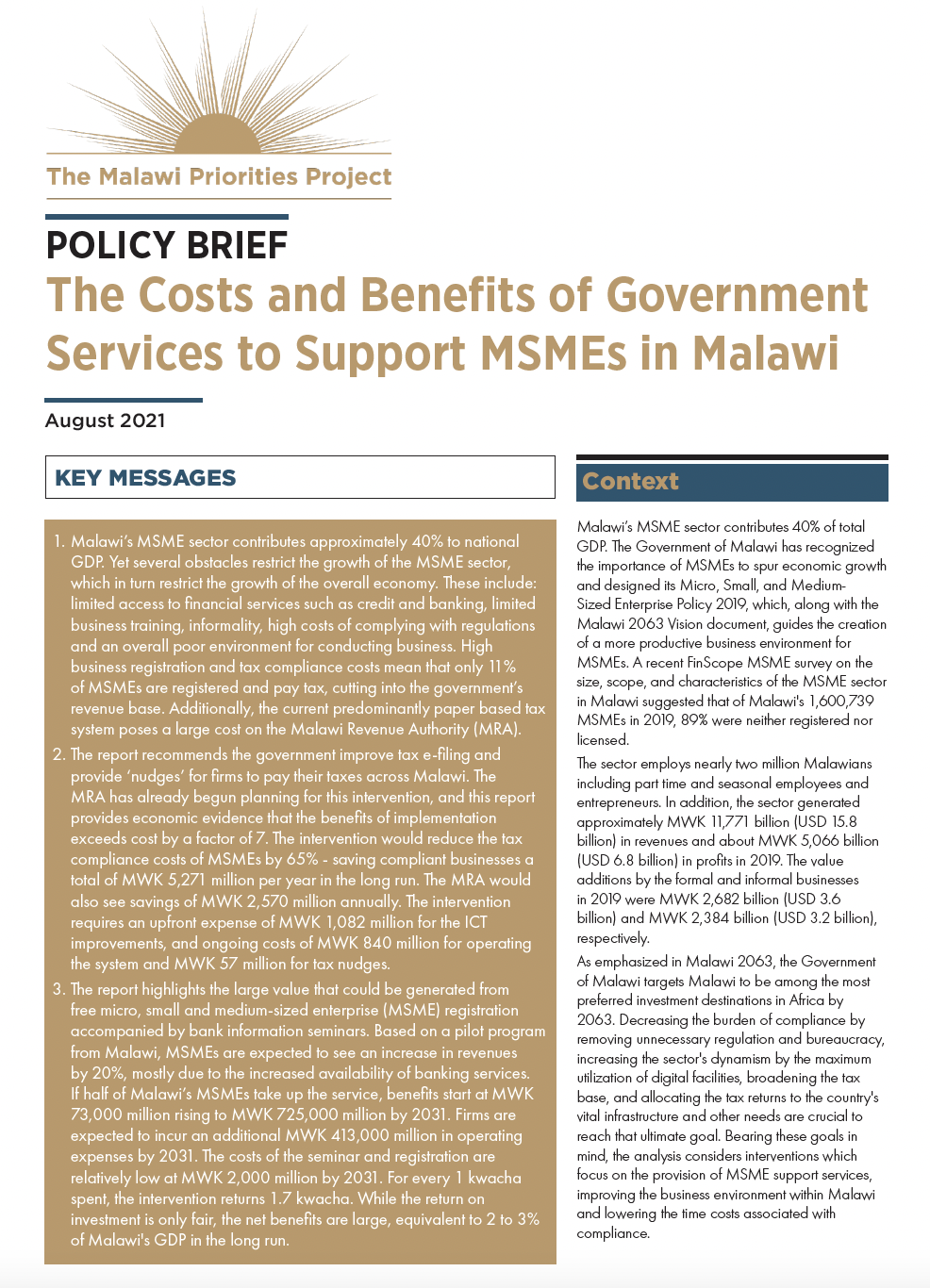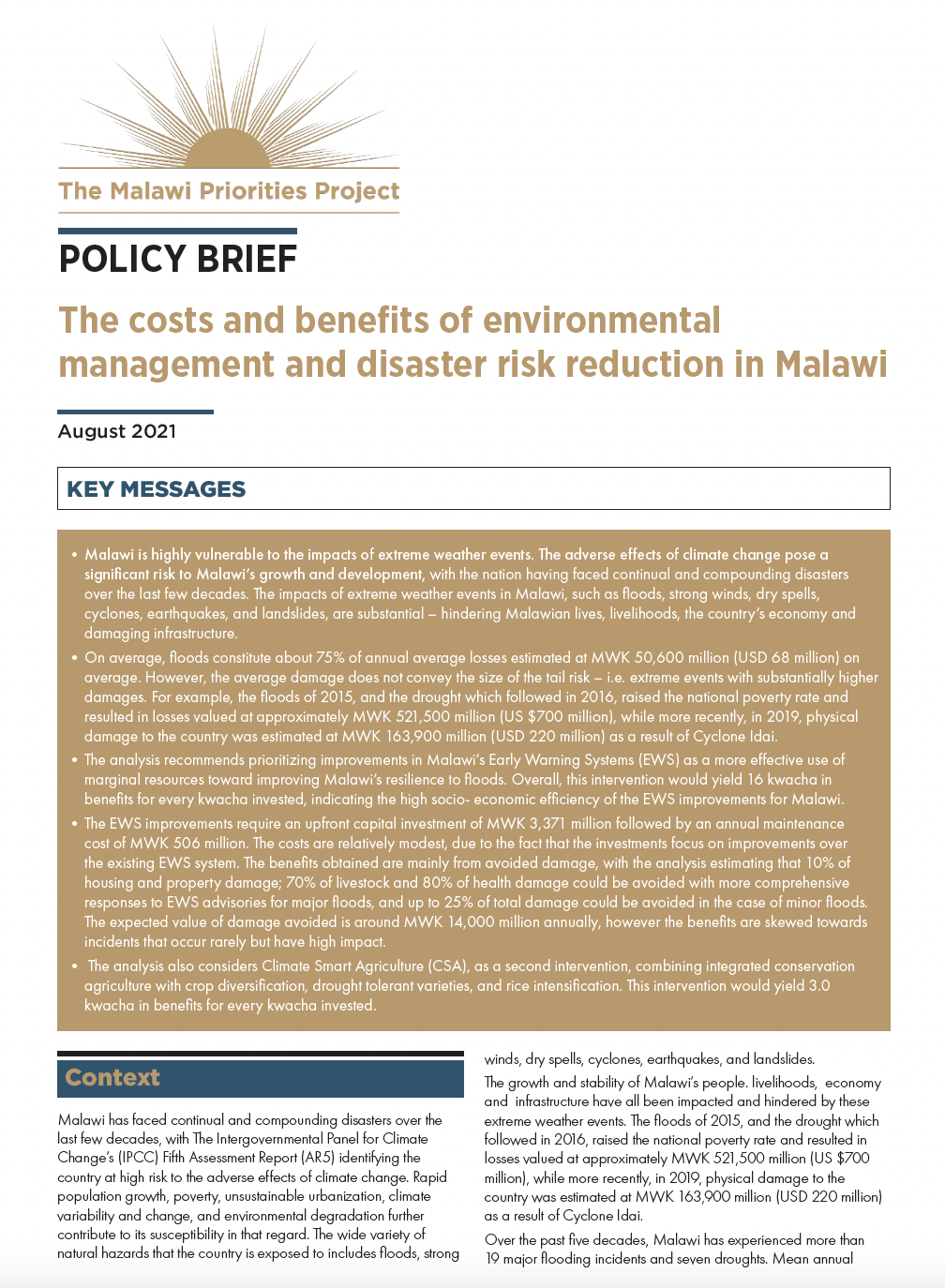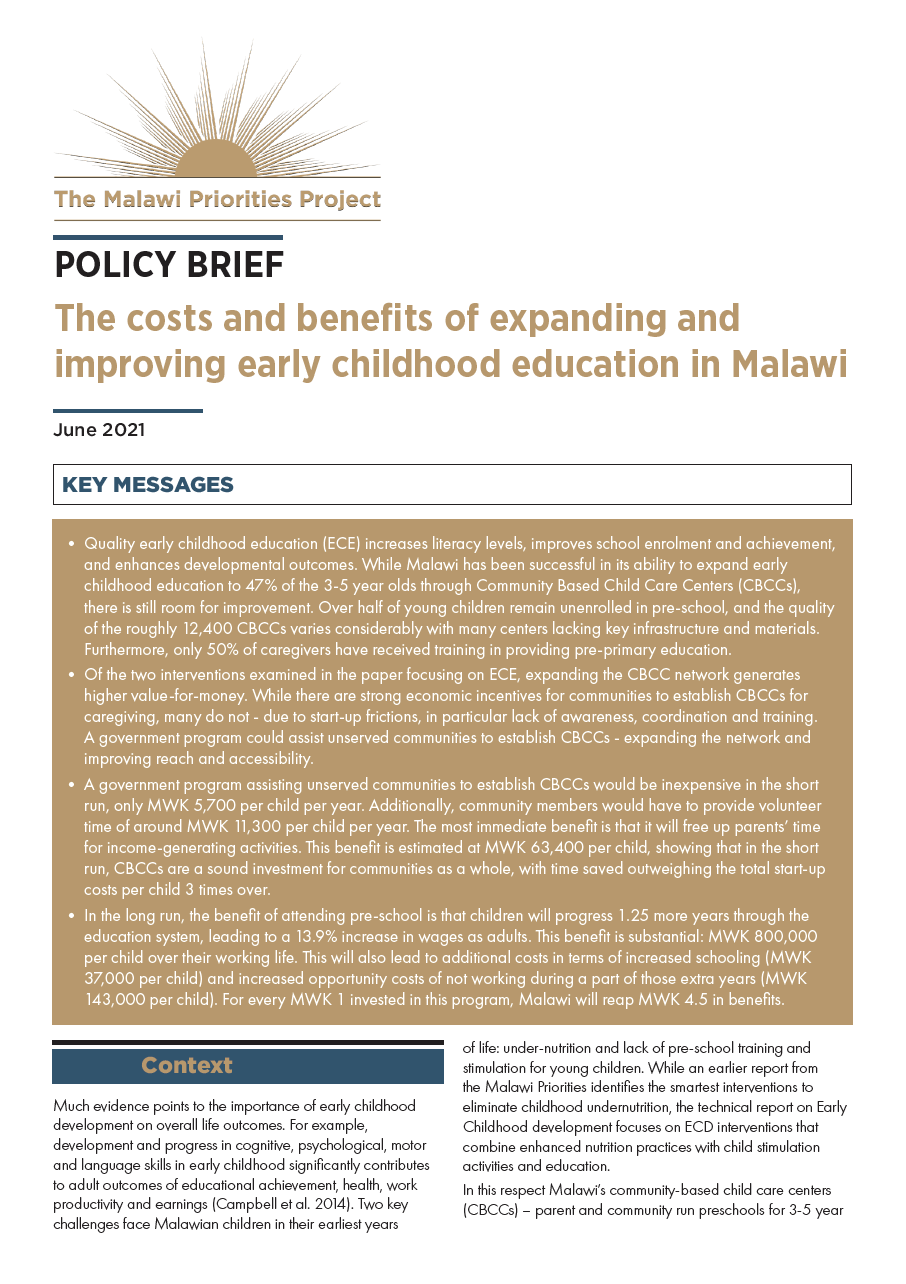Policy Briefs

The fisheries sector is very important to Malawi’s economy, livelihoods, food security and biodiversity. One estimate puts the total contribution of the sector at 7.2% of GDP while employing 700,000 people either directly or indirectly. Unfortunately, there is evidence of extreme overfishing, with 50% more craft than should be the case for maximum sustainable yield. Almost 90% of all nets used are illegal, with mesh sizes that are too small, capturing juvenile and spawning fish which curtail the reproductive capacity of fish species. This paper estimates that in 2018, profit from the fisheries sector was more than 5 times larger […]

Malawi’s MSME sector contributes approximately 40% to national GDP. Yet several obstacles restrict the growth of the MSME sector, which in turn restrict the growth of the overall economy. These include: limited access to financial services such as credit and banking, limited business training, informality, high costs of complying with regulations and an overall poor environment for conducting business. High business registration and tax compliance costs mean that only 11% of MSMEs are registered and pay tax, cutting into the government’s revenue base. Additionally, the current predominantly paper based tax system poses a large cost on the Malawi Revenue Authority […]

The analysis recommends prioritizing improvements in Malawi’s Early Warning Systems (EWS) as a more effective use of marginal resources toward improving Malawi’s resilience to floods. Overall, this intervention would yield 16 kwacha in benefits for every kwacha invested, indicating the high socio- economic efficiency of the EWS improvements for Malawi.

The primary recommendation of the paper is to pursue a combination of two interventions: The development of a new water source from the Shire River and a roll out of the E-Madzi program (automated water kiosks) to Blantyre. The combined intervention yields 3.2 kwacha for every kwacha invested, higher than either intervention alone. However, the analysis shows that the BWB should wait until the new supply is fully implemented, and that a sufficient proportion goes to informal settlements, before considering any rollout of E-Madzis. The benefits of the e-Madzis investment are greater the more water that is supplied to kiosks, reducing wastage, water operating costs and waiting time.

More than half of urban residents live in informal settlements or in informal dwellings in areas designated for housing. While regulations and housing permits are critical, compliance with these regulations is of equal importance.

This analysis grew from two distinct research questions: “Where should Malawi focus its resources to achieve industrialisation?” and “Which policies can effectively address youth unemployment and underemployment?” In considering the challenges and opportunities for both areas, the authors recognised a number of overlaps and common spaces for growth, and as such, the analysis was merged. Malawi’s young workforce participants are reliant on Malawi’s ability to improve industrialisation, without which any amount of skilled labour would remain unused.

Tourism contributes 7.7% to Malawi’s GDP, and sub-optimal capacity utilization of tourism facilities and services indicates that there is opportunity for growth. One of the keys to unlocking Malawi’s potential in tourism and other sectors like mining and forestry is investment in passenger transport infrastructure. Due to the fact that it is landlocked, transport costs in Malawi are among the highest in the region. Furthermore, road infrastructure is poor and below internationally accepted standards. The implication of the analysis is that ensuring paved roads can provide significant benefits to the Malawian economy. The intervention will increase international tourism receipts by 30%.

Despite being endowed with substantial minerals, gemstones, and waterbodies, Malawi’s mining and fisheries sectors have been unable to fully take advantage of these resources for wealth creation. The analysis highlights two large-scale projects that could increase the value generated by mining and fisheries: Artisanal and small-scale mining ‘landing centers’; and the Chipoka Port Fisheries Project. These projects would contribute towards Malawi’s wealth creation and industrialization goals, for example improving the share of mining from 0.8% of GDP in 2020 to 10% in 2030 and increasing the value-addition from forestry, livestock, fishing from MWK 406,000 million to MWK 600,000 million by 2030.

Although malaria is a largely preventable and treatable disease, it is a significant cause of mortality, morbidity, and productivity loss in Malawi. This study estimates that in 2019, malaria generated health and productivity losses equivalent to MWK 94,770 million – or 1.7 per cent of GDP. Increasing insecticide resistance and less than optimal (60%) care-seeking behaviour represent two of the most pressing issues facing the country when it comes to reducing the burden of malaria. The main policy recommendation from this cost-benefit analysis is that the National Malaria Control Program (NMCP) should fully adopt piperonyl butoxide (PBO) insecticide-treated bednets (ITNs) and rollout community-informed mass media to increase the rate at which people seek formal care when they, or their children, have fever. PBO ITNs have been shown to have a greater effectiveness against mosquitos compared to the ITNs that Malawi has used in the past.

Malawi enacted land reform policy in 2016. Implementation has been initiated but there is much work left to do with 4.7 million hectares of land in the country still untitled. Secure land tenure has substantial benefits for Malawians with 15 percent of households having a dispute over land and one out of five households fearing that their land would either be encroached upon or taken away from them. Implementing the land reform policy would require MWK 64,920 million in upfront costs for land titling, adjudication, and demarcation of 4.7 million hectares.

Quality early childhood education (ECE) increases literacy levels, improves school enrolment and achievement, and enhances developmental outcomes. While Malawi has been successful in its ability to expand early childhood education to 47% of the 3-5 year olds through Community Based Child Care Centers (CBCCs), there is still room for improvement. Over half of young children remain unenrolled in pre-school, and the quality of the roughly 12,400 CBCCs varies considerably with many centers lacking key infrastructure and materials. Furthermore, only 50% of caregivers have received training in providing pre-primary education.

In Malawi, 6 out 7 girls are not enrolled in secondary school, while 3 out of 7 girls are married before the age of 18. Common factors drive these two startling statistics: insufficient number of secondary schools, limited labor market opportunities for girls and cultural norms and practices that normalize early marriage. Missing out on secondary school and getting married early has a number of negative effects, including earlier pregnancy, poorer health outcomes for mothers and children, increased domestic violence and higher national fertility rates. Estimating the social and economic costs of child marriage, this report finds that each case of child marriage costs Malawian society around MWK 9 million.

